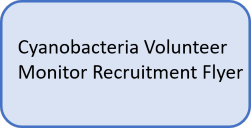Cyanobacteria
Evaluation of In-Lake Management Options for Lake Carmi - Franklin - Vermont
October 22, 2018
Posted to web February 6, 2018. Updated October 22, 2018.
Model Simulations of Mixing Technologies to Reduce Cyanobacteria in Lake Carmi - Phase 2 Report
August 24, 2018
Posted to web August 24, 2018. Updated October 22,2018.
Vermont Cyanobacteria Monitors
We’re looking to learn more about conditions on Vermont’s lakes – You can help!
Cyanotoxin Monitoring Program
The summer of 2024 marks the tenth year of DWGPD's voluntary cyanotoxin monitoring program for public drinking water systems. This program offers no-cost analysis of raw and finished water for microcystin (a potent liver toxin produced by some species of cyanobacteria) to surface water systems across the state. Samples are analyzed on a weekly basis from July to early November by the Vermont Agriculture and Environmental Laboratory (VAEL).
Thank you for your patience as we update this page and consolidate data for ease of access.
Cyanobacteria
What are Cyanobacteria?

